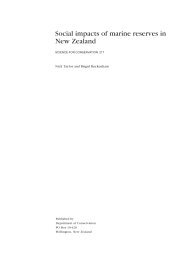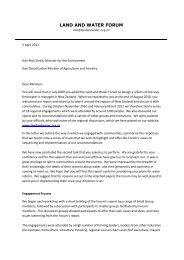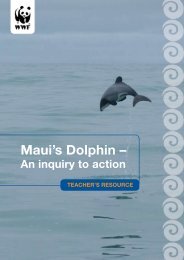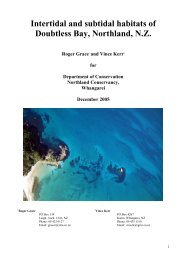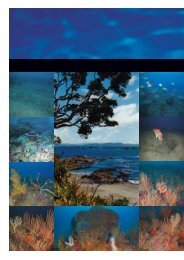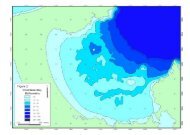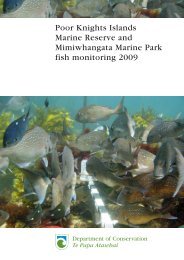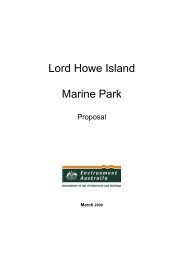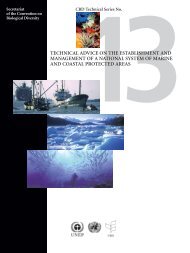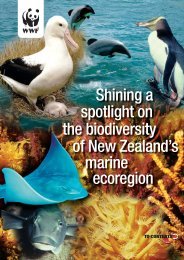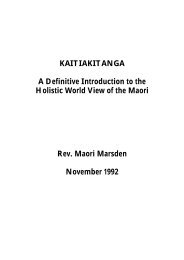Habitats and Ecological Values of the Hokianga ... - MarineNZ.org.nz
Habitats and Ecological Values of the Hokianga ... - MarineNZ.org.nz
Habitats and Ecological Values of the Hokianga ... - MarineNZ.org.nz
You also want an ePaper? Increase the reach of your titles
YUMPU automatically turns print PDFs into web optimized ePapers that Google loves.
R.J. DAVIDSON: V. KERR<br />
HABITATS AND ECOLOGICAL VALUES OF HOKIANGA HARBOUR<br />
customary food ga<strong>the</strong>ring or to manage o<strong>the</strong>r fishing in <strong>the</strong> taiapure. Anyone may fish in a taiapure.<br />
Examples are Palliser Bay, Maketu <strong>and</strong> Karitane (East Otago).<br />
Mataitai<br />
Mataitai reserves are areas that are identified traditional fishing grounds <strong>and</strong> where tangata whenua<br />
have a special relationship (Ministry <strong>of</strong> Fisheries 1991). They have a special status under <strong>the</strong><br />
Fisheries Act to recognise <strong>and</strong> provide for non-commercial customary food ga<strong>the</strong>ring by Maori.<br />
Both Maori <strong>and</strong> non-Maori may fish in mataitai reserves, but <strong>the</strong>y are managed by a Maori<br />
Committee or kaitiaki who can make by-laws restricting or prohibiting <strong>the</strong> taking <strong>of</strong> fish, aquatic<br />
life or seaweed in <strong>the</strong> reserve, if <strong>the</strong>y consider this necessary for sustainable management. An<br />
example includes Rapaki (Lyttleton Harbour).<br />
6.2 Concepts for <strong>the</strong> protection <strong>of</strong> <strong>the</strong> ecological values <strong>of</strong> <strong>Hokianga</strong> Harbour<br />
The following section outlines concepts <strong>and</strong> considerations for <strong>the</strong> management <strong>of</strong> all or parts <strong>of</strong><br />
<strong>Hokianga</strong> Harbour.<br />
6.2.1 Protection versus human use<br />
Estuarine <strong>and</strong> Harbour areas in New Zeal<strong>and</strong> <strong>and</strong> worldwide are traditionally areas <strong>of</strong> high human<br />
activity <strong>and</strong> use. They are areas where people live, work <strong>and</strong> play. They are areas that people <strong>of</strong>ten<br />
build a close personal association. Management <strong>of</strong> <strong>Hokianga</strong> Harbour is no different <strong>and</strong> its<br />
management is a complex issue. It is <strong>the</strong>refore critical that options for its protection take into<br />
account <strong>the</strong> wide range <strong>of</strong> existing human activities, aspirations <strong>and</strong> cultural issues. These need to<br />
be placed in perspective with <strong>the</strong> variety <strong>of</strong> ecological values <strong>and</strong> <strong>the</strong>ir location in <strong>the</strong> Harbour. In<br />
this regard <strong>the</strong>re will always be areas <strong>of</strong> agreement <strong>and</strong> conflict between human use <strong>of</strong> <strong>the</strong> Harbour<br />
<strong>and</strong> <strong>the</strong> protection <strong>of</strong> its ecological, scientific or conservation values.<br />
Protection recommendation 1:<br />
The Department <strong>of</strong> Conservation should carefully assess <strong>the</strong> reasons for protection (i.e. to protect all<br />
species, to protect <strong>the</strong> habitat <strong>of</strong> species, to protect particular species or <strong>the</strong>ir habitats, to protect<br />
species in vulnerable stages <strong>of</strong> <strong>the</strong>ir life history). Once <strong>the</strong> reasons for protection have been<br />
determined it will become more clear what protection mechanism/s will achieve <strong>the</strong> objective/s.<br />
Once <strong>the</strong> reasons for protection have been determined <strong>the</strong>y should be placed into context with o<strong>the</strong>r<br />
issues in <strong>the</strong> Harbour. There needs to be: (a) assessment <strong>of</strong> <strong>the</strong> ecological/conservation values <strong>of</strong><br />
<strong>the</strong> area/s under consideration; (b) assessment <strong>of</strong> existing human use/s <strong>of</strong> <strong>the</strong> area, <strong>and</strong> (c)<br />
assessment <strong>of</strong> existing human activities that compromise ecological values <strong>and</strong> <strong>the</strong> objectives <strong>of</strong> <strong>the</strong><br />
protection mechanism.<br />
6.2.2 Protection mechanisms <strong>and</strong> options<br />
There are a wide variety <strong>of</strong> protection mechanisms that can be applied to marine areas. Some<br />
mechanisms extend over both intertidal <strong>and</strong> subtidal habitats, while o<strong>the</strong>rs apply only to intertidal<br />
areas. Any successful protection <strong>of</strong> <strong>Hokianga</strong> Harbour will be involve lengthy public discussion<br />
<strong>and</strong> debate <strong>and</strong> ultimately be a compromise between human use <strong>and</strong> protection <strong>of</strong> ecological values.<br />
PAGE 25 3/06/2005 DAVIDSON ENVIRONMENTAL LTD 389/2001





